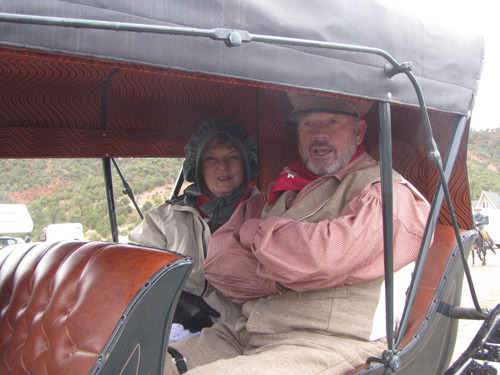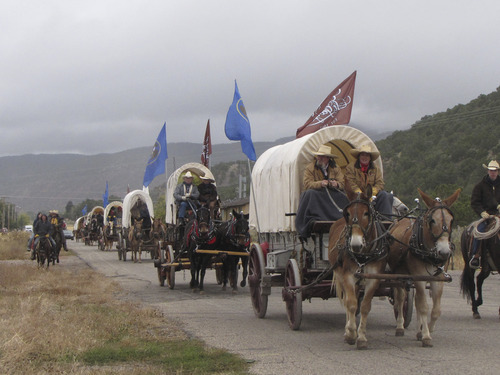This is an archived article that was published on sltrib.com in 2011, and information in the article may be outdated. It is provided only for personal research purposes and may not be reprinted.
Parowan • "Forward ho!"
On that command Saturday morning, about 300 people in horse-drawn wagons, on horseback, in handcarts or walking streamed out of the fairgrounds in Parowan for an eight-day journey to St. George, more than 100 miles away.
The wagon train was formed to recognize the 150-year anniversary of the settlement of St. George by a hearty group of Mormon pioneers who traveled from Salt Lake City to Parowan, the first settled town in southern Utah, to stage for the final push.
St. George Mayor Dan McArthur — who came up with the idea of the city-sponsored trek and is making the trip dressed in period wool pants, vest and hat and traveling in a horse-drawn buggy — said the original trip was made by about 900 settlers in two waves in November and December 1861.
Shortly after that, he said, St. George incorporated on Jan. 17, 1862, becoming the 13th city in Utah and with about 70,000 residents today is the largest in the state's southern region.
He said the early pioneers faced difficult challenges in the early days of the settlement established originally by then LDS Church President Brigham Young as a cotton mission.
Besides menacing clouds of flies and mosquitoes, infant mortality was also a problem.
"Of the 150 babies born in the first year or two, 90 of them died," said McArthur.
While nighttime temperatures are dipping into the 20s this time of year, the trekkers have tents and sleeping bags and don't have to worry much about cooking since meals for the travelers are being catered.
After parading down Main Street in Parowan as part of the town's Fall Festival, Saturday's wagon train used back roads to roll into nearby Enoch where they made their first camp.
Beginning on Monday the group will head south on back highways and across public and private lands in Iron and Washington counties, hoping to arrive in Ivins, just north of St. George, on Friday.
On Saturday the wagon train will parade through Santa Clara and into St. George for a festive ending at Worthen Park.
The wagon train experience is nothing new for Monroe resident Walt LeFevre who has participated in wagon trains or in parades for several decades.
Sitting on a wagon he built mostly himself for about $9,000 and navigated by Missouri mules Jake and Jessie, LeFevre said he has been on re-enactments of up to six weeks at a time.
He said his ancestors knew about the early pioneer days in the region with his great-grandfather, William LeFevre, helping build the original Fort Parowan before marrying two wives and having 13 children with each one.
Walt LeFevre's wife, Roberta, said she likes "almost everything" about the wagon train experience. "You can get away from television," she said. "I don't miss the news."
She also said the pace of the wagon train allows one to enjoy the scenery more than from a vehicle.
The trip is special for teenager Swasey Boiss, taking part in the trek with her family from Salem.
While not riding in the family's wagon, Boiss is riding her horse born on the same day she was, named Peek-a Boo.
Boiss said she and Peek-a-Boo will both share their 16th birthday on Monday.
Re-enacting wagon trains is also a pastime for the MacDonald family, which has a ranch in Alton.
Dennis MacDonald said his homemade wagon, pulled by two Haflinger horses, is part of the thrill of the ranching life.
His son, Toby, 15, looked the part on his horse wearing seasoned chaps and cowboy hat with a lariat hung on the horn of his saddle.
He said he has been in several wagon train re-enactments and several cattle drives.
"That is what it is like living on a ranch," said Toby MacDonald.
A documentary of the journey by the modern-day pioneers is being filmed and will be included with interviews of St. George residents talking about their heritage, said Carlos Robles, special projects coordinator for St. George.
He said the wagon train experience and interviews will also be chronicled in a book that should be available to the public in January.







